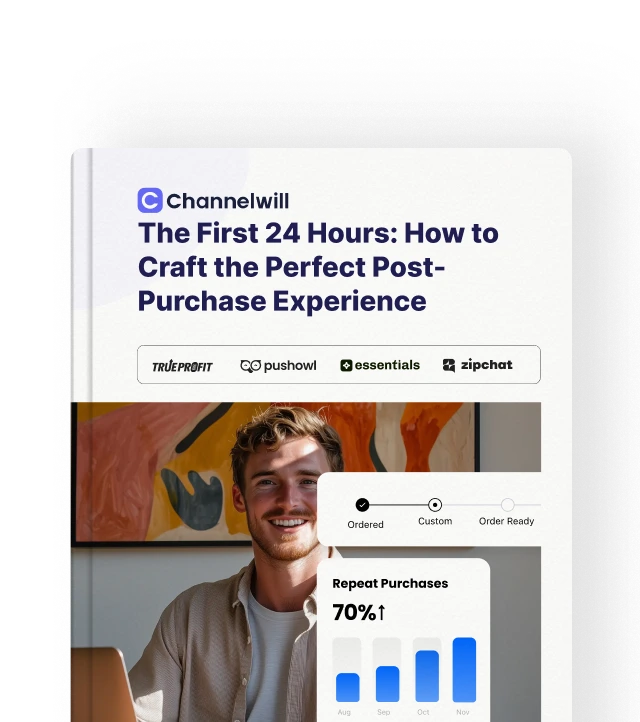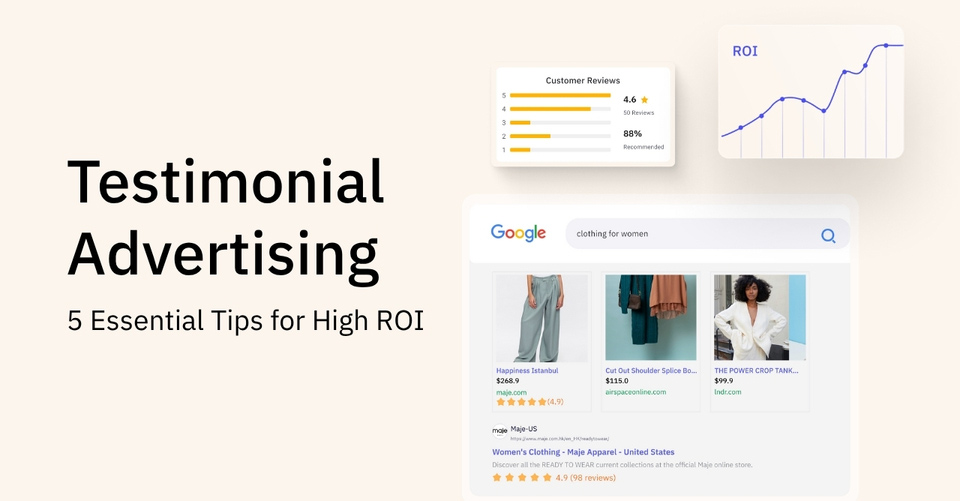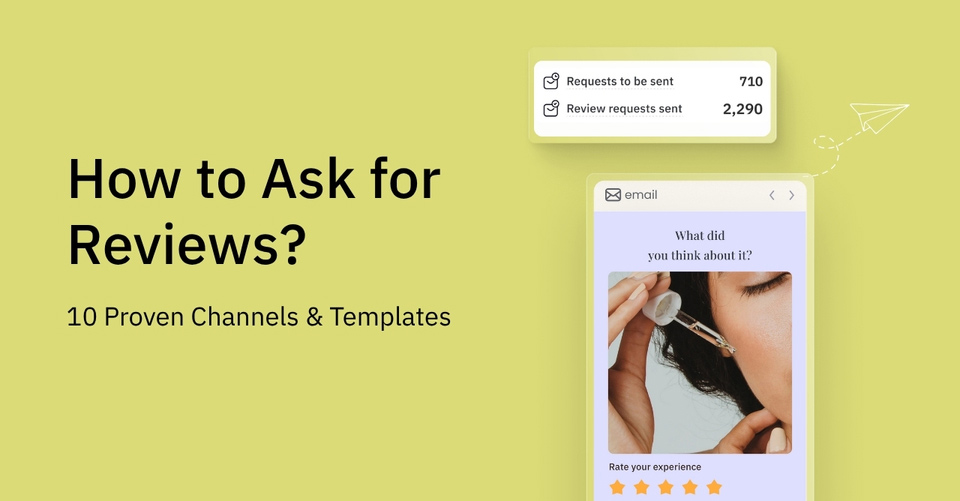Have you ever thought about why some businesses make so much revenue even with fewer ads? Some may have been really lucky. But most of them invested in loyalty marketing.
One report in 2024 showed that loyalty programs bring five to seven times more revenue than what they cost. You spend less but get more in return. Who won’t like that?
The good news? Loyalty marketing is easy if you have the right strategy and tools in place. And that’s why we wrote this guide.
We’ll cover what loyalty marketing is, why it’s important, top strategies you can follow, and our most recommended apps to help you get started.
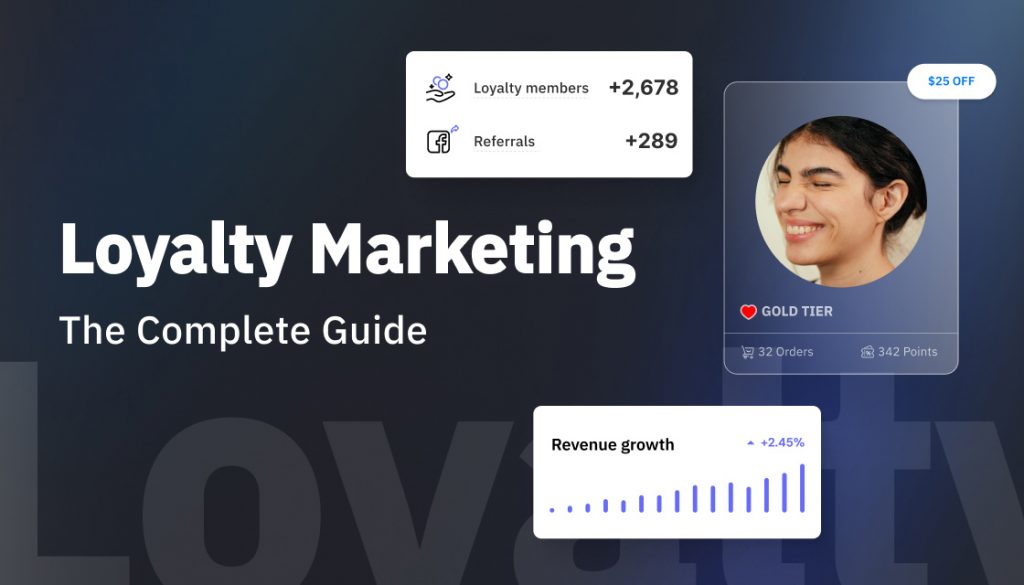
What Is Loyalty Marketing and How Does It Work?
Loyalty marketing is a business approach that focuses on customer retention, repeat purchases, and brand loyalty. And you achieve those through reward systems and loyalty programs.
Let’s say you have a customer named Lily. She loved your skincare brand so much that she bought five sets of your face brightening collection in less than a year. So, you decided to create a special reward program for Lily (and customers like her).
Your program perks included a 20% discount during your store’s anniversary and free shipping on all orders. Lily and other repeat customers were so happy with this exclusive treatment that they kept buying from you. And they even referred your shop to the people they know!
That’s how loyalty marketing works (or at least the basic idea of it).
What makes it different from the usual customer acquisition is… the focus. They are both for making more revenue. But customer acquisition is more about finding new customers, while loyalty marketing is more about maintaining a relationship with your existing buyers.
Okay. Now you know what loyalty marketing is. Let’s discuss why you should include it in your marketing strategy next.
Why is Loyalty Marketing Important in Ecommerce?
Loyalty marketing is important for your ecommerce store because it allows you to retain customers, get higher revenue (and lifetime value), lower acquisition costs, and promote your brand organically.
Let me discuss each benefit to you.
Better Customer Retention
Did you know that 79% of Americans choose to buy from brands where they are part of a loyalty program? That alone shows how it encourages customers to stay and keep buying from your brand (vs. your competitors).
But that’s not all. The same study also showed that 70% of these customers engage more with brands than those who aren’t loyalty program members. And that’s because they literally get a small happiness boost every time they earn points.
It’s part of psychology as it lets you create a strong emotional connection. When you make your customers feel valued, they are more likely to stay with you.
Higher Revenue and Customer Lifetime Value
Of course, when your customers decide to stick around, they’ll naturally spend more money with your store. And that can improve your customer lifetime value and your revenue.
Let’s say you have two customers: Rachel (a new customer you got from ads) and Monica (a solid loyalty member). They bought the same $100 skincare set during Black Friday.
But because Rachel was new to your brand and didn’t feel any special connection, she never came back. You made $100 from her, which wasn’t bad, but… that’s it.
Now, let’s look at Monica. Since she’s in your loyalty program (where she earned points, got birthday discounts, early access, etc.), she bought four more times and spent $500 total in the same year. Plus, she referred two friends who each paid $150.
Their actions might have been similar, but you earned 7x more revenue from one of them. And it’s all because of customer loyalty marketing.
Lower Acquisition Costs
Another awesome thing about loyalty marketing is that it helps you get more buyers without spending much on ads.
One of our clients, PetMo, used to burn so much money on digital ads just to keep their sales numbers high. That’s not good because it wasn’t sustainable for their business.
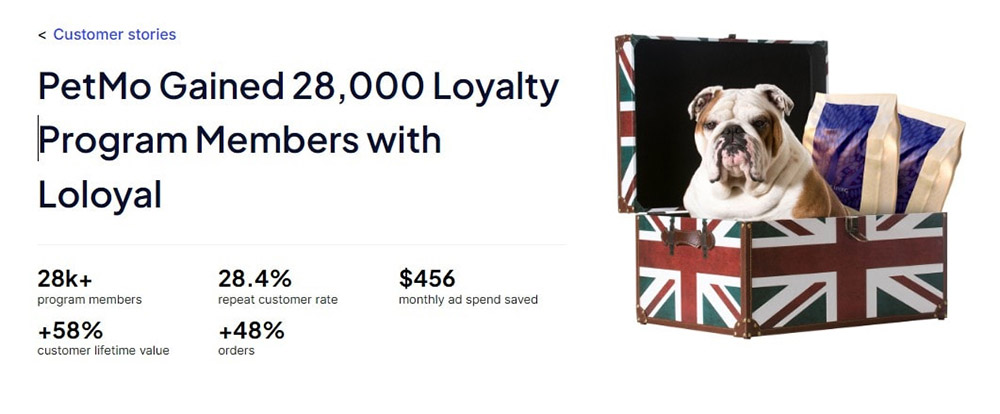
But once they set up their loyalty program with us, they saved $456 monthly (a $5,000+ saving in a year!) from ads.
How was that possible? Their loyal customers became their marketing team and started recommending their pet products and brand to family and friends.
Organic Brand Promotion
With a good customer loyalty strategy, you can turn your customers into “voluntary” marketers and brand advocates. They love your brand (and what you offer), so they’ll be talking about it without you asking them to.
And this is actually proven by data. We found that over 50% of customers say that being part of a loyalty program keeps them connected to brands they care about. It simply means that if you really want to benefit from word-of-mouth marketing, you have to build a loyalty program that satisfies your existing customers first.
Do All E-Commerce Stores Need a Loyalty Marketing Strategy?
Our short answer? Yes. Ecommerce stores and online businesses need a loyalty marketing strategy.
Whatever you sell, you’ll get something from creating customer loyalty. But there are some product types (and industries) where a loyalty marketing approach can be more effective than others.
And that’s what I’ll talk about next.
Product Types That Benefit Most From Loyalty Marketing
Fashion, beauty and skincare, foods, and subscription services are some of the common ecommerce products that get the biggest wins from loyalty programs. And here’s why:
- Fashion: Most of us buy clothes, shoes, and accessories way more often than we buy a new laptop. So, providing rewards and programs works really well here. Take the Urban Outfitters’ rewards program. They offer their members early access to new styles, exclusive promotions and events, and a cash reward. That encourages more sales (and customer engagement).
- Beauty and skincare brands: Loyalty marketing is more effective when there’s a “recurring” purchase. And this industry meets that requirement, as 63% of people buy skincare products at least once a month.
- Food and beverage: If you’re selling highly consumable products like snacks, coffee, tea, wine, and meal kits, you can take advantage of loyalty programs. That’s because your customers need to restock regularly (more often than the skincare items). And there’s a huge chance they’ll buy from you a few times a week or a month.
- Subscription services: Loyalty strategies still work for this type of ecommerce. Brands like Ipsy and Barkbox are some great examples of reward-based and personalized programs. But the goal will be more on reducing cancellations and improving the ROI.
We’re done naming the product types where a customer loyalty program will make a difference. But how about those industries where it might not be the best option? Let’s take a look at them next.
Ecommerce Products Where Loyalty Programs Are Less Effective
Some products that fall into this are luxury products, furniture, and electronics. Why? Because they are expensive and customers don’t buy them frequently enough to enjoy the perks of a loyalty program.
Let’s say you’re selling gadgets. A customer who bought a laptop worth $2,399 from your store would use that for about 3-5 years (sometimes even longer). The same goes if you’re selling cabinets.
But just to clarify, we’re not saying that loyalty marketing won’t work for these product types… at all. But your approach has to focus more on building customer relationships and encouraging referrals (and not on repeat purchases).
You can still make more revenue and increase customer satisfaction… in different ways.
Top Loyalty Marketing Strategies for Online Stores
The top loyalty marketing strategies for ecommerce stores include point-based, tier-based, and referrals. I’ll tell you how and why each works.
| Strategy | Best Use Case | Brand Examples |
| Point-Based | Great for stores that want to reward every purchase and small actions. | Adidas, Sephora, The North Face |
| Tiered-Based | Ideal for ecommerce businesses that want customers to spend more. | Ulta, Lancome, Best Buy |
| Referrals | Perfect for stores that want to grow their customer base through word-of-mouth and use trust networks. | Allbirds, Glossier |
Point-based
Point-based loyalty programs reward customers with points based on the actions they take. Then, they can use these points to redeem rewards like free products, free shipping, discounts, etc.
But how do you implement a point-based system? You first need to set up a signup process. Then, you have to decide how many points you’ll give (i.e, 1 point for every $5) and which actions they have to take to earn the points.
Once you’re done with that, you can think of the rewards you’ll give.
You might have seen many ecommerce stores use this loyalty program strategy. And that’s because it’s easy for your customers to understand… and for you to manage.
Pros
✅ Your customers can see how close they are to earning their next reward
✅ You can encourage specific behaviors like buying more, writing reviews, or sharing on social media
Con
❌ Some customers hoard points instead of using them (you may not get the result you want if this happens)
Tier-based
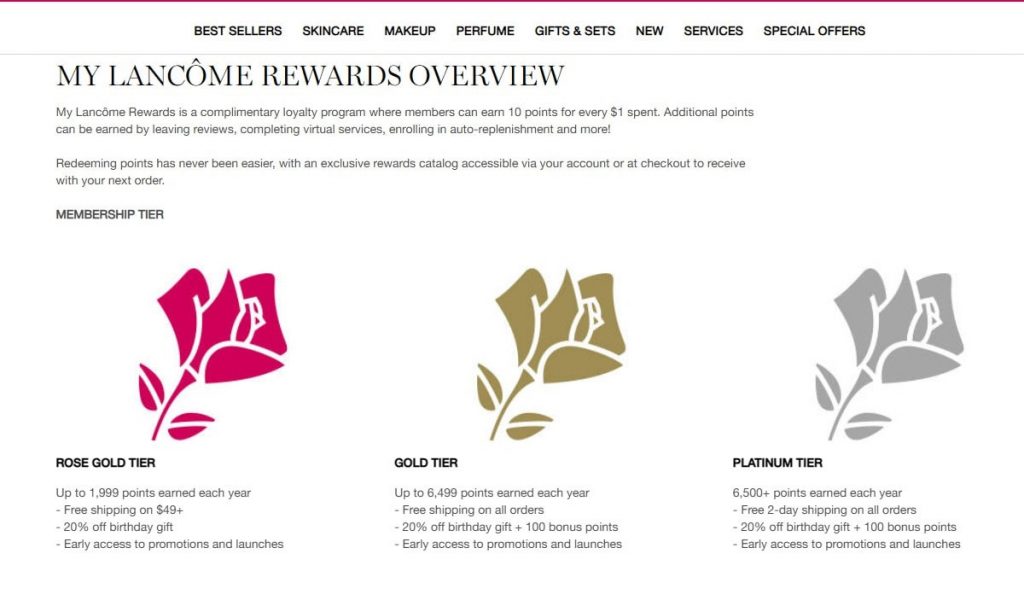
Tiered loyalty programs create different membership levels where your customers can unlock better rewards as they spend more or engage with your brand.
Imagine you ran a clothing store. You wanted to improve your customer retention, so you set up three tiers: Silver (after $300 spent), Gold (after $700), and Platinum (after $1,500).
Your Silver members get 10% off their purchase, Gold ones receive 15% off plus free shipping. And the Platinum members get 20% off, free shipping, and a buy one, take one promo.
A tiered loyalty program is another ecommerce store’s favorite because it’s effective. It’s some sort of a status upgrade, and we humans naturally want to reach the next level. So, when your customers see they are only $150 away from Gold status, they’re more likely to make another purchase… to get those better perks.
Pros
✅ It creates a clear path for your customers to earn better rewards by spending more
✅ It makes your biggest spenders feel special with exclusive perks
Con
❌ New customers (or those who don’t spend much) might feel left out of the best rewards
Referrals
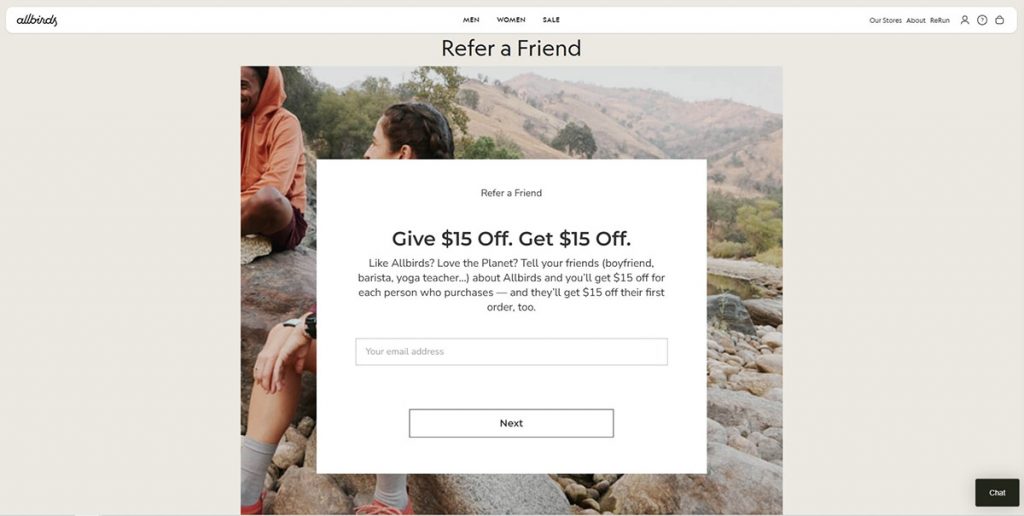
Referral programs reward your existing customers for bringing you new buyers.
We like to call it “relationship-focused marketing” because you’re using the trust and connections your customers already have with their friends and family.
And here’s how it works: you give your current customers a unique referral code or link to share with people they know. When someone uses that code to make a purchase, both the referrer and the new customer get a reward (awesome!). Who wouldn’t want that, right?
Referrals work magically because people trust recommendations from people they know more than any form of ads. So if your cousin recommends a hair shampoo that makes her hair super soft and shiny, you’re way more likely to buy it than the shampoo you saw in a random Instagram ad.
New research also revealed that referred customers are 31-57% more likely to refer others compared to regular customers. You get a snowball effect where one happy customer can bring in multiple new buyers over time.
Pros
✅ Referrals cost less than traditional advertising
✅ It’s a win-win loyalty marketing strategy
Con
❌ It only works if your current customers are happy enough
PRO-TIP: Whatever strategy you choose, you have to keep it simple. It’s best to provide every single detail your customer will need in the loyalty page and avoid overcomplicating the reward system.
Best Practices for Implementing Loyalty Programs
Some of the best practices for implementing loyalty programs include: setting clear goals, understanding your customers, choosing simple rewards, setting up the right tech stack, and promoting it effectively.
- Start With Your Goals: Before you pick any tools or rewards, decide what you’re trying to accomplish. Do you want customers to buy more frequently, spend more per order, or refer friends? Your goal determines everything else about your program design.
- Know Your Customers: Look at your current customer data to understand buying patterns. If most customers only shop twice a year, a points program might not work as well as a referral system. But if they buy monthly, then the point-based system can work.
- Pick Simple Rewards: You have to choose rewards that your customers actually want. For example, cash discounts and free shipping usually win over branded merchandise for most loyalty program members… who prefer practical benefits.
- Set Up Your Tech Stack: Make sure to connect your loyalty platform with your email marketing and customer service tools. So, it’s easier for you to send targeted campaigns and track program performance.
- Launch and Promote: Your loyalty marketing program will also need promotion to get people to actually join. You can start by emailing your existing customers since they’re most likely to sign up. Then, add signup prompts to your checkout page and product pages (with a welcome bonus) to encourage more participants.
How to Choose the Right Tool for Your Loyalty Program
The right loyalty tool should match your business size, work smoothly with your current systems, and offer the features you actually need. Let me give you more details:
Business Size and Volume
You should consider your monthly order volume so that the loyalty platform you choose will make financial sense.
For example, if you’re running a small store and have around 100 orders monthly, free and basic plans are the best for you.
But if you’re a high-volume store doing 1,000+ orders per day, you need a platform that can handle bulk point awards and manage thousands of active loyalty members.
Features to Look For
You should focus on features that match how your customers actually shop.
Points and referral programs work for most stores. But you might need tier-based if you want to reward your highest spenders with exclusive deals.
Birthday perks are also great if you want to create more personal connections (these little touches really do make a difference).
Platform Integration
Your loyalty tool needs to work with your existing setup, and this is where many store owners get burned.
Make sure to check if it connects with your CRM, email marketing platform, review apps, or your customer service tools. Because poor integrations mean extra manual work… and it can give you a headache when collecting customer data.
Some of our clients have been there, and we won’t recommend the experience.
Customization Options
It’s also best to pick a tool that lets you redesign your page and edit colors, messaging, and reward types.
But the “customization level” will depend on your skills and how much branding consistency you want to maintain with your store and loyalty program.
If you’re not tech-savvy, we suggest you stick with platforms that offer pre-built templates you can easily modify. But if you have design skills (or maybe a developer on your team), you can look for tools that give you full control over your loyalty program design.
Reporting and Analytics
And of course, tracking is an “unskippable” part of a successful loyalty program. You need to know if you’re driving more sales (or you’re just giving away free stuff).
What we recommend is tracking these three important metrics: member engagement rates, redemption rates, and incremental sales. If your program grows, you can add more advanced analytics like CLTV and referral conversion rates.
Popular Loyalty Tools to Consider
The three loyalty tools we recommend are Channelwill Loloyal, Smile.io, and Yotpo. Here’s why:
- Channelwill’s Loloyal handles points, referrals, VIP tiers, and social engagement rewards well. Our platform works with both online and offline orders. Plus, you can connect it smoothly with Shopify POS, and it also supports multiple languages.
- Smile.io offers points-based rewards and referral programs with good integrations for Klaviyo and Gorgias. It’s also easy for beginners to set up.
- Yotpo is a flexible loyalty and rewards program with VIP tiers, referral campaigns, and advanced analytics.
| Description | Channelwill Loloyal | Smile.io | Yotpo |
| Key Features | Points, referrals, VIP tiers, social rewards | Points, referrals, VIP programs | Reviews + loyalty, points, referrals |
| Free Trial | Yes | No. But offers a free plan | Yes (and a free plan) |
| Shopify Rating | 4.9/5 | 4.9/5 | 4.6/5 |
| Starting Price (Shopify) | $19/month | $49/month | $199/month |
| Popular Integrations | Shopify POS, Klaviyo, Judge.me | Klaviyo, Gorgias, Shopify | Shopify, Google, Facebook |
| Best For | Most ecommerce stores that need a reliable loyalty program app | Ecommerce stores of all sizes | Brands that want more loyalty program customization |
Final Thoughts
Now, you’ve learned everything you need to build a loyalty program that drives repeat sales and keeps customers coming back. It’s time to put in the work and start your own.
If you want to launch your loyalty program in just a few hours, get started with our Loloyal app for free. You’ll have a working program up and running in no time.

Easy to customize your brand loyalty program
FAQ About Loyalty Marketing
The four stages of loyalty are cognitive, affective, conative, and action loyalty. These stages show how your customers move from price-focused shoppers to brand advocates who automatically choose your store and recommend it to others.
The 4 C’s of customer loyalty are commitment, communication, care, and consistency. These help you build stronger relationships by staying dedicated, keeping customers informed, showing genuine care, and giving a quality experience every single time.
Note: This blog was originally written in English and translated using an automated tool to make the content accessible to a global audience. We believe in sharing valuable insights with everyone and apologize for any inaccuracies. If you spot any errors, please feel free to contact us for corrections. Your feedback helps us improve and ensures the content’s value is fully realized.

Content Director | 9+ years decoding B2C & B2B eCommerce, obsessed with SaaS and retail storytelling
Words are my weapon—crafting killer copy, decoding trends, and turning data into gold. When not strategizing: Coffee addict, pun enthusiast, and book lover. Ready to level up your eCommerce game? Let’s chat. ☕️

